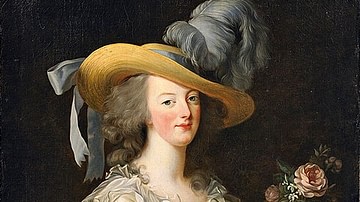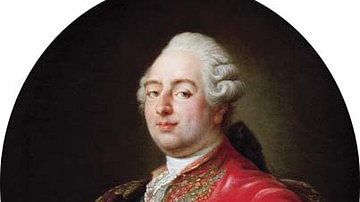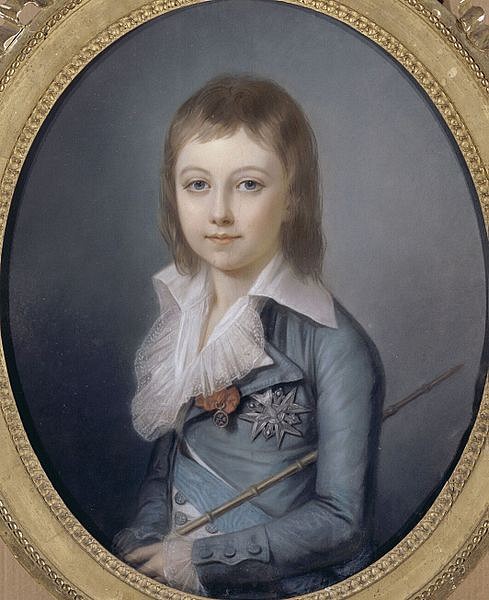
Louis XVII of France was the regnal name of Louis-Charles de France (l. 1785-1795), the younger son of King Louis XVI of France (r. 1774-1792) and Queen Marie Antoinette (l. 1755-1793). Although Louis-Charles never actually reigned as king, he was recognized by royalists as France's legitimate monarch upon the execution of his father during the French Revolution (1789-1799).
Birth & Questioned Parentage
Louis-Charles de France was born on Easter Sunday, 27 March 1785 at the Palace of Versailles. His was a long-awaited birth; for many years, the marriage of King Louis XVI and Queen Marie Antoinette had failed to produce any children. This had been a serious problem, both for the institution of monarchy, which needed to appear strong amidst a steadily declining public opinion, and for the king and queen themselves, whose childlessness had made them the subject of ridicule not only in France but across Europe. When Marie Antoinette finally gave birth to an heir to the French throne in 1781, the boy, Louis-Joseph, was weak and sickly, and courtiers feared a shaky succession brought about by his early death. Yet Louis-Charles, the royal couple's second son, was robust and healthy; his birth secured the succession and seemed to promise a continuation of Louis XVI's line for at least another generation.
Louis-Charles was named after both his father (Louis) and his mother's favorite sister Queen Marie Carolina of Naples and Sicily, whose nickname was Charlotte (the feminine form of Charles). He was given the title Duke of Normandy upon his birth. Louis-Charles was the third of four children to be born to Louis XVI and Marie Antoinette; his elder sister, Marie-Thérèse, was born in December 1778, and his older brother, Louis Joseph Xavier François, was born in October 1781. A younger sister, Madame Sophie, was born in July 1786 but lived only 11 months, dying in June 1787. Marie Antoinette also had four adopted children, three of whom served as playmates for their royal stepsiblings and lived with the royal family at the queen's expense until her arrest in 1792. Most accounts indicate that Marie Antoinette loved her children, though she was particularly fond of Louis-Charles, who grew into a strong and sweet-natured boy.
The births of all four children became the subject of scandalous rumor, as people began to whisper that their true father was not Louis XVI but Count Axel von Fersen. Fersen was a Swedish nobleman who had become an intimate of Marie Antoinette's and was widely believed to be her lover. This rumor was especially prevalent surrounding Louis-Charles' parentage, since Fersen had returned to the French court nine months before the prince was born. Modern scholars generally dismiss these accusations, as there is little evidence to suggest the father was anyone other than the king. The births of the children were never questioned by Louis XVI himself, either publicly or privately, suggesting that he was regularly paying his wife conjugal visits. This is supported by courtiers of Versailles, who noted in their diaries that Louis XVI and Marie Antoinette were spending a lot of time together around the time Louis-Charles was conceived. Furthermore, biographer Antonia Fraser notes that one recorded instance of Louis XVI's nocturnal visits to his wife's chambers corresponds perfectly with Louis-Charles' birthdate. While many scholars acknowledge that Fersen and Marie Antoinette carried on a love affair, it is clear from their letters that they took caution to avoid accidental pregnancies.
Although the children were most likely fathered by the king, the public's belief to the contrary further damaged Marie Antoinette's reputation in the wake of the affair of the diamond necklace. She was widely regarded as a sexually depraved, morally bankrupt foreigner, a leech on the national treasury. She became the personification of their frustrations with the monarchy, with France's mounting state debt, and with the poor quality of life under the Ancien Régime. In May 1789, Louis XVI called a meeting of the three estates of pre-revolutionary France to Versailles to sort out these issues. But the meeting, the Estates-General of 1789, could not begin until the Third Estate (commoners) validated its own elections, something it refused to do until the upper two estates (clergy and nobility) consented to a vote by head rather than by estate; the Third Estate feared unequal representation if their demands were not met. Louis XVI attempted to mediate this impasse, but his attention was soon called away by dreadful news – the young dauphin, Louis-Joseph, was dead.
A New Dauphin
Louis-Joseph had always been frail. In 1786, he contracted the initial fevers that were the first signs of the tuberculosis that eventually killed him. Aside from his perpetual illnesses, the boy suffered from a curvature of the spine that made it difficult for him to walk. On 4 June 1789, Louis-Joseph died at the Château de Meudon, aged seven and a half; that same morning, a sobbing Louis-Charles was informed that his brother was dead and that he was now the dauphin and was presented with the Order of St. Louis. In his grief, Louis XVI went to mass before shutting himself away from the world, refusing to meet with representatives of the Third Estate. The king and queen were appalled that the nation barely took time to mourn the dauphin at all, so preoccupied were they with the high-stakes dramatics of the Estates-General. "At the death of my poor little dauphin," the queen lamented, "the nation hardly seemed to notice" (Fraser, 277).
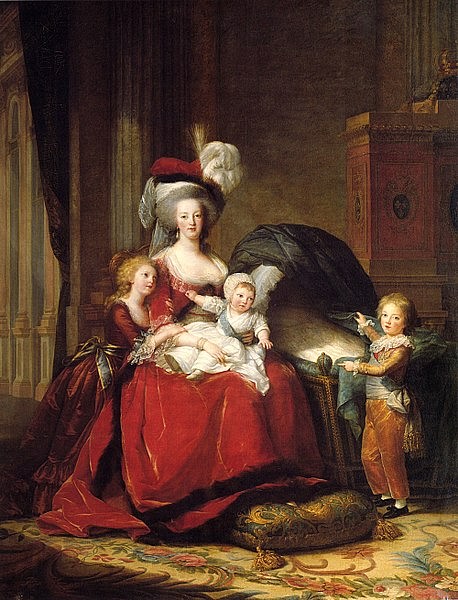
During this lapse in royal attention, the Third Estate declared itself to be a National Assembly, vowing never to disband until it had given France a new constitution. Louis XVI attempted to regain control of the situation by calling 30,000 soldiers into the Paris region, but all this did was spark rioting that resulted in the Storming of the Bastille on 14 July. Begrudgingly, the king backed down as the National Assembly spent the summer passing radical reforms that limited the privileges of the crown and the upper classes. Louis XVI's refusal to consent to these reforms led 7,000 outraged market women to march from Paris to Versailles on 5-6 October 1789 in the Women's March on Versailles. They accosted the National Assembly and surrounded the palace. A group of them broke in during the night, murdered two guards, and chased Marie Antoinette through the halls, threatening to kill her. The situation was defused by the National Guards, but Louis XVI was compelled to accept the revolutionary decrees and accompany the women back to Paris with his family. The royal family was thereafter installed in the Tuileries Palace in Paris, where they were kept as virtual prisoners under the watchful eyes of the National Guard and the citizens of France.
Abolition of the Monarchy
Louis XVI, Marie Antoinette, and their two surviving children resided in the Tuileries for close to three years. Louis-Charles found it to be cold and ugly compared to the splendor of Versailles; to cheer him up, and perhaps to distract him from the realities of the Revolution, Marie Antoinette adopted a girl around his age, nicknamed Zoë, to be his playmate. By June 1791, Louis-Charles was six years old. He showed great affection for his surviving sister and had also grown to exhibit signs of pride and a quick temper, traits that were not present in Louis XVI's apathetic personality. Courtiers took this as an indication that Louis-Charles would become a strong and willful king.
Yet Louis XVI was not entirely docile. Although he publicly praised the Revolution, he secretly conspired to flee France with his family and instigate counter-revolution abroad. At ten at night on 20 June 1791, Louis-Charles was woken by servants and was made to dress as a girl. He was led to a waiting carriage where he was joined by his sister, his parents, and his paternal aunt Madame Elizabeth, all in disguise. Under the cover of darkness, the carriage left the Tuileries and headed toward the border with the Austrian Netherlands (Belgium) where Austrian soldiers were waiting to receive them.

They never made it that far. The next day, when the carriage stopped to change horses, Louis XVI was recognized and detained at the village of Varennes-en-Argonne. The royal family was escorted back to Paris by a crowd of National Guards and patriotic citizens. Two deputies of the National Assembly crammed themselves into the already crowded carriage; one of them, Jérôme Pétion, amused himself by teasing the dauphin, tugging on the boy's long, blond hair and making him read revolutionary slogans off his buttons. The Flight to Varennes destroyed any remaining trust in the French monarchy and caused a republican movement to take root. For now, the monarchy was kept in place, but it was weakened and subjected to a constitution; Louis XVI, once known by the absolutist title King of France and Navarre was now simply called King of the French; likewise, Louis-Charles was no longer dauphin, but rather Prince Royal.
But tensions did not dissipate, especially as the French Revolutionary Wars broke out; people began to (rightly) suspect that the king and queen were hoping for a French defeat and were sending military secrets to France's enemies. Tensions boiled over when a popular insurrection led to the Storming of the Tuileries Palace on 10 August 1792. The royal family, warned ahead of time, were able to hide out in the Legislative Assembly as a bloody battle raged between their Swiss Guards and the rebellious Parisians. When it was over, the Insurrectionary Commune of Paris sent representatives to the Legislative Assembly, demanding the royal family be handed over, and Louis XVI, Marie Antoinette, their children, and Madame Elizabeth were imprisoned in the Tower of the Temple. A month later, the monarchy was officially abolished, and a French Republic was declared; henceforth, Louis XVI was known as Citizen Louis Capet.
Imprisonment
For the first months of their imprisonment, the royal family tried to live their lives as normally as possible. They played games together during their allotted time in the prison's courtyard, and Louis would read Roman histories to his children before bed. Louis XVI kept up with Louis-Charles' education, and personally gave him lessons, particularly on geography. Yet there was only so much normality to be had; privacy was nonexistent, as the family was under constant surveillance from guards and were required to always speak in clear French. The Temple was flooded with visitors; after the revolutionaries decided to put Louis XVI on trial for treason, lawyers were constantly buzzing about as well. When it became clear he was going to be found guilty, Louis spent Christmas Day 1792 revising his will. He left a message to Louis-Charles, telling him that if he should ever have the misfortune to become king, he should not seek revenge but look only to his subjects' happiness.

Citizen Louis Capet was guillotined on the morning of 21 January 1793. The night before, he had visited his family one final time; the royal valet, Cléry, describes a heart-wrenching scene in which the two wailing children cling to their father's legs. With the trial and execution of Louis XVI, seven-year-old Louis-Charles was immediately hailed by royalists as King Louis XVII of France. He was never coronated, of course, and the French monarchy had officially been abolished, but royalists maintained that the crown passed to a successor immediately after a reigning monarch's death. In March 1793, royalist rebels rose against the French Republic in the War in the Vendée, proclaiming Louis XVII as their king and issuing currency bearing his likeness; during the subsequent federalist revolts, other parts of France recognized Louis XVII as well. The boy king's paternal uncle, the Comte de Provence, who had successfully escaped France, proclaimed himself to be regent. This was contested by the Habsburgs, who argued that honor should fall to Marie Antoinette as the king's mother.
In the Care of Simon
Of course, all of these were moot points so long as Louis-Charles remained in the hands of the revolutionaries. In early 1793, several plans were made to rescue him and his mother, but all of them were half-hearted and never came close to reaching fruition. By the summer, the French Republic felt itself becoming constricted on all sides, as the prospect of a Coalition military victory and a subsequent Bourbon Restoration became more likely. In response, commissioners were sent on 3 July to separate Louis-Charles from his mother. For an hour, Marie Antoinette refused to let them take him, even when the commissioners threatened to kill her. It was not until they threatened to kill Marie-Thérèse that she tearfully relented. Louis-Charles was kept in another room in the Temple, and the sounds of his nightly sobbing could be heard by his tormented mother.
Louis-Charles was then given over to the care of a sans-culotte cobbler named Antoine Simon. Although barely literate himself, Simon was entrusted by the Committee of General Security to oversee the boy's re-education as a patriotic citizen rather than a prince. Royalist writers would later tell horror stories of Simon's barbaric abuses; he supposedly plied the boy with wine to the point of drunkenness, taught him to speak in foul language, and regularly beat him every time he cried. Allegedly, Simon forced the boy to have sex with prostitutes, thereby deliberately infecting him with venereal diseases. None of these stories have been proven, and they should be taken with a grain of salt since they were relayed by royalist writers hostile to the revolutionaries, but it is worth noting that Marie-Thérèse referred to Simon as a "monster" in her memoirs.
On 6 October 1793, just before the trial and execution of Marie Antoinette, journalist Jacques-René Hébert, Simon, and their compatriots visited Louis-Charles and, by one means or another, persuaded him to sign a written statement claiming he had been sexually molested by his mother and Madame Elizabeth. Louis-Charles, still an impressionable child, did so, and his statement was used as evidence in the trial. Marie-Thérèse was outraged at her brother for agreeing to substantiate such lies, but Marie Antoinette told her to forgive him. The queen was guillotined on 16 October 1793.
In January 1794, Simon left the Temple after securing a receipt for the safe transfer of the prisoner; during this time, Louis-Charles was declared to have still been in good health. For the next half year, the boy's condition was unknown, as the Temple's records were destroyed during the Bourbon Restoration. After the fall of Maximilien Robespierre on 28 July 1794 (Simon was guillotined the same day), Paul Barras arrived at the prison. He reported that for half a year, the boy had been kept in a dark room, barricaded in like a caged animal, with no human contact other than his guards. Barras had Louis-Charles cleaned and assigned him to the care of Jean-Jacques Laurent.
Death & Rumored Survival
Louis-Charles was treated much better in the care of Laurent but was reported to have remained completely silent the entire time; Laurent explained that the boy had taken a vow of silence as penance for the lies he had made about his mother. In May 1795, the prisoner was reported to be seriously ill. His regular doctor, P. J. Desault, was summoned but suddenly died before he could examine the boy, giving rise to rumors of poison. Louis-Charles died on 8 June 1795 in the Temple at age 10, of scrofula, a form of tuberculosis. As was tradition, his heart was removed and placed in a crystal urn; the rest of the body was interred without ceremony in Sainte Marguerite Cemetery.
Immediately upon Louis-Charles' death, his uncle, the Comte de Provence, began styling himself King Louis XVIII of France. After the Restoration of 1815 finally brought Louis XVIII to his throne, no fewer than 40 individuals came forth claiming to be Louis XVII and claiming the rights to his estates. The claimant who convinced the most people was Karl Wilhelm Naundorff, a German clockmaker, who arrived in Paris in 1833. Naundorff claimed that he had been saved by Paul Barras, who had smuggled him out of the Temple to impress his mistress, Joséphine de Beauharnais. To avoid arousing suspicion, Barras had apparently put a deaf-mute in the Temple in his place; the deaf-mute was in turn replaced by the cadaver of a child who had died from scrofula.
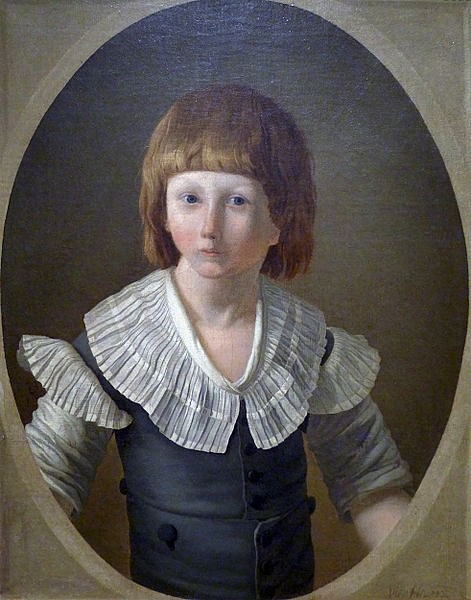
Despite Naundorff's convoluted story, several courtiers old enough to remember the days of Louis XVI believed him. However, Naundorff was expelled from France in 1836 after bringing a lawsuit against the Duchess of Angoulême for the return of Louis XVII's private belongings. When Naundorff died in 1845, his tomb was inscribed with "Louis XVII, King of France and Navarre", and Dutch authorities allowed his children to carry the name Bourbon. His descendants made further appeals to reclaim their supposed inheritance in 1850 and again in 1874.
Rumors of Louis XVII's survival persisted until 1999 when a section of the aorta from the preserved heart was sent to a laboratory for testing. It was compared to DNA samples from multiple family members, such as a strand of Marie Antoinette's hair, and against the DNA of then-living maternal relatives like Queen Anne of Romania. The findings, announced in April 2000, proved that the mummified heart was indeed that of Louis-Charles, discrediting the rumors of his survival.



